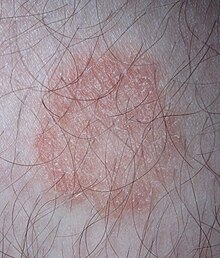| Dermatophytosis | |
|---|---|
| Other names | Ringworm, tinea |
 | |
| Ringworm on a human leg | |
| Specialty | Dermatology, Internal Medicine |
| Symptoms | Red, itchy, scaly, circular skin rash[1] |
| Causes | Fungal infection[2] |
| Risk factors | Using public showers, contact sports, excessive sweating, contact with animals, obesity, poor immune function[3][4] |
| Diagnostic method | Based on symptoms, microbial culture, microscopic examination[5] |
| Differential diagnosis | Dermatitis, psoriasis, pityriasis rosea, tinea versicolor[6] |
| Prevention | Keep the skin dry, not walking barefoot in public, not sharing personal items[3] |
| Treatment | Antifungal creams (clotrimazole, miconazole)[7] |
| Frequency | 20% of the population[8] |
Dermatophytosis, also known as tinea and ringworm, is a fungal infection of the skin[2] (a dermatomycosis), that may affect skin, hair, and nails.[1] Typically it results in a red, itchy, scaly, circular rash.[1] Hair loss may occur in the area affected.[1] Symptoms begin four to fourteen days after exposure.[1] The types of dermatophytosis are typically named for area of the body that they affect.[2] Multiple areas can be affected at a given time.[4]
About 40 types of fungus can cause dermatophytosis.[2] They are typically of the Trichophyton, Microsporum, or Epidermophyton type.[2] Risk factors include using public showers, contact sports such as wrestling, excessive sweating, contact with animals, obesity, and poor immune function.[3][4] Ringworm can spread from other animals or between people.[3] Diagnosis is often based on the appearance and symptoms.[5] It may be confirmed by either culturing or looking at a skin scraping under a microscope.[5]
Prevention is by keeping the skin dry, not walking barefoot in public, and not sharing personal items.[3] Treatment is typically with antifungal creams such as clotrimazole or miconazole.[7] If the scalp is involved, antifungals by mouth such as fluconazole may be needed.[7]
Dermatophytosis has spread globally, and up to 20% of the world's population may be infected by it at any given time.[8] Infections of the groin are more common in males, while infections of the scalp and body occur equally in both sexes.[4] Infections of the scalp are most common in children while infections of the groin are most common in the elderly.[4] Descriptions of ringworm date back to ancient history.[9]
- ^ a b c d e "Symptoms of Ringworm Infections". CDC. December 6, 2015. Archived from the original on 20 January 2016. Retrieved 5 September 2016.
- ^ a b c d e "Definition of Ringworm". CDC. December 6, 2015. Archived from the original on 5 September 2016. Retrieved 5 September 2016.
- ^ a b c d e "Ringworm Risk & Prevention". CDC. December 6, 2015. Archived from the original on 7 September 2016. Retrieved 5 September 2016.
- ^ a b c d e Domino FJ, Baldor RA, Golding J (2013). The 5-Minute Clinical Consult 2014. Lippincott Williams & Wilkins. p. 1226. ISBN 9781451188509. Archived from the original on 2016-09-15.
- ^ a b c "Diagnosis of Ringworm". CDC. December 6, 2015. Archived from the original on 8 August 2016. Retrieved 5 September 2016.
- ^ Teitelbaum JE (2007). In a Page: Pediatrics. Lippincott Williams & Wilkins. p. 274. ISBN 9780781770453. Archived from the original on 2017-04-26.
- ^ a b c "Treatment for Ringworm". CDC. December 6, 2015. Archived from the original on 3 September 2016. Retrieved 5 September 2016.
- ^ a b Mahmoud A. Ghannoum, John R. Perfect (24 November 2009). Antifungal Therapy. CRC Press. p. 258. ISBN 978-0-8493-8786-9. Archived from the original on 8 September 2017.
- ^ Bolognia JL, Jorizzo JL, Schaffer JV (2012). Dermatology (3 ed.). Elsevier Health Sciences. p. 1255. ISBN 978-0702051821. Archived from the original on 2016-09-15.